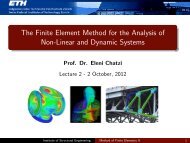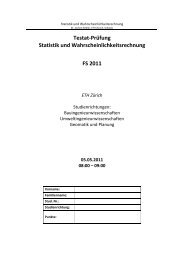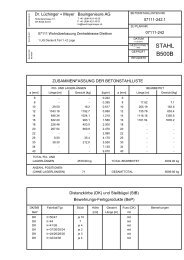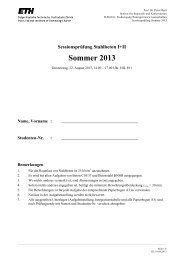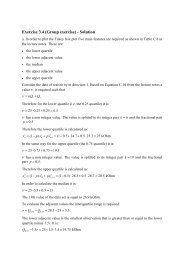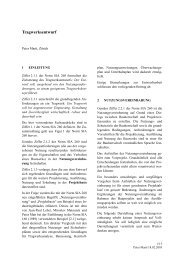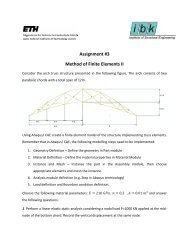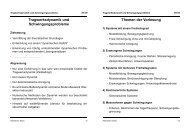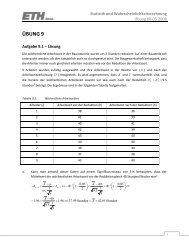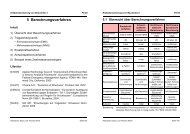A New Program for the Design of Cable-Stayed Bridges Summary 1 ...
A New Program for the Design of Cable-Stayed Bridges Summary 1 ...
A New Program for the Design of Cable-Stayed Bridges Summary 1 ...
Create successful ePaper yourself
Turn your PDF publications into a flip-book with our unique Google optimized e-Paper software.
displacements. Such an element does not depend on <strong>the</strong> global structure and, fully<br />
representing <strong>the</strong> physics <strong>of</strong> <strong>the</strong> modelled structure's segment, can be added to or removed<br />
from <strong>the</strong> numerical model just like <strong>the</strong> corresponding structure's segment can be added or<br />
removed in real life (see section 4).<br />
• Post-tensioning <strong>for</strong>ces or pre-camber values which have to be found automatically by <strong>the</strong><br />
program can be <strong>for</strong>mulated as initial element displacements whose magnitudes are found<br />
through conditions to be fulfilled (see section 5).<br />
• The erection <strong>of</strong> a cable-stayed bridge is an evolutionary process and <strong>the</strong> simplest way to<br />
describe it with accuracy is a list <strong>of</strong> <strong>the</strong> changes occurring in <strong>the</strong> system in chronological<br />
order (a "chronological" objects list, see section 6).<br />
• In order to take displacements locked in concrete and creep into account it is necessary to<br />
know <strong>the</strong> displacements <strong>of</strong> <strong>the</strong> structure in <strong>the</strong> stages prior to <strong>the</strong> stage being analyzed (see<br />
section 7).<br />
• The program BRIDE should be user friendly enough to be applicable both in <strong>the</strong> bridge<br />
construction industry and <strong>for</strong> teaching purposes.<br />
4. Element description through its local stiffness matrix and a set <strong>of</strong> initial<br />
displacements<br />
The geometry <strong>of</strong> space frame finite element models such as those analyzed by <strong>the</strong> program BRIDE<br />
is described through <strong>the</strong> Cartesian coordinates <strong>of</strong> <strong>the</strong> nodes and through <strong>the</strong> element's incidence<br />
nodes. In addition, every element requires section and material properties. Once <strong>the</strong> Cartesian<br />
coordinates <strong>of</strong> <strong>the</strong> incidence nodes, <strong>the</strong> material and <strong>the</strong> section <strong>of</strong> <strong>the</strong> element are defined, its<br />
elastic response can be <strong>for</strong>mulated by means <strong>of</strong> a local 12x12 elastic stiffness matrix.<br />
If we would consider an existing bridge already modelled in a simulation program (see figure 2),<br />
take a concrete cutter, cut out a<br />
segment <strong>of</strong> <strong>the</strong> structure modelled with<br />
a single finite element (see figure 3)<br />
and determine its geometry in <strong>the</strong><br />
unloaded state, we would notice that<br />
its geometry does not correspond to<br />
<strong>the</strong> geometry <strong>of</strong> <strong>the</strong> finite element. In<br />
fact, displacements “locked-in” during<br />
<strong>the</strong> hardening <strong>of</strong> <strong>the</strong> concrete, creep,<br />
Fig. 2 Step 1. Consider an element in <strong>the</strong> numeric<br />
model <strong>of</strong> an existing bridge<br />
Fig. 3 Step 2. Cut out a structure segment<br />
corresponding to a finite element <strong>of</strong> an existing bridge<br />
considered as a "conditional" load, see section 5).<br />
shrinkage and <strong>the</strong> pre-camber would<br />
have slightly changed <strong>the</strong> shape <strong>of</strong> <strong>the</strong><br />
cut out, thus unloaded segment (see<br />
figure 4).<br />
The vector a initial <strong>of</strong> size 12 (3<br />
translation and 3 rotation components<br />
<strong>for</strong> each incidence node) containing<br />
<strong>the</strong> difference between <strong>the</strong> cut out<br />
segment's and <strong>the</strong> finite element's<br />
geometry can be <strong>for</strong>mulated as follows:<br />
a initial = a h + a cr + a sh (1)<br />
where a h is <strong>the</strong> contribution <strong>of</strong> <strong>the</strong><br />
concrete locked-in displacements, a cr<br />
that <strong>of</strong> creep and a sh is that <strong>of</strong><br />
shrinkage (<strong>the</strong> pre-camber is not taken<br />
into account here because it is<br />
One way to model <strong>the</strong> cut segment correctly is to reproduce its displacements by submitting <strong>the</strong><br />
finite element to a set <strong>of</strong> initial self-equilibrating <strong>for</strong>ces f (see figure 5) producing <strong>the</strong> initial



